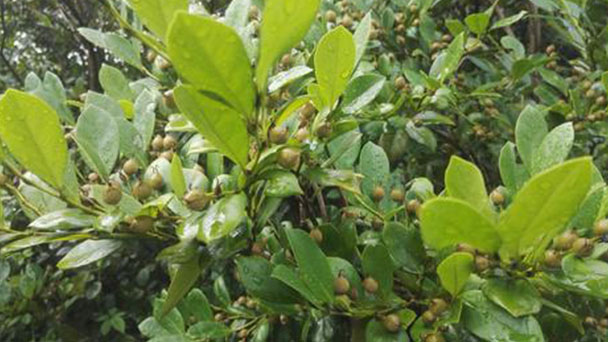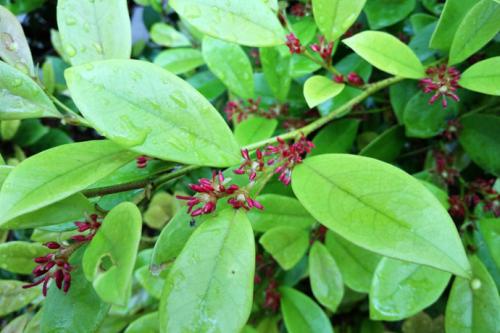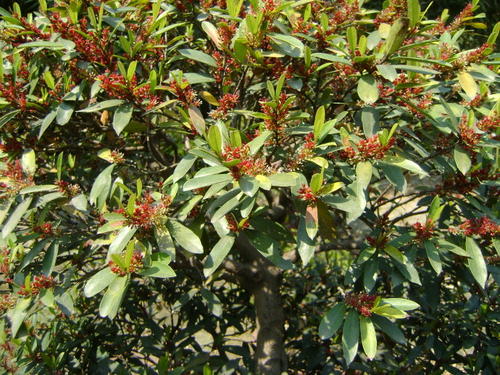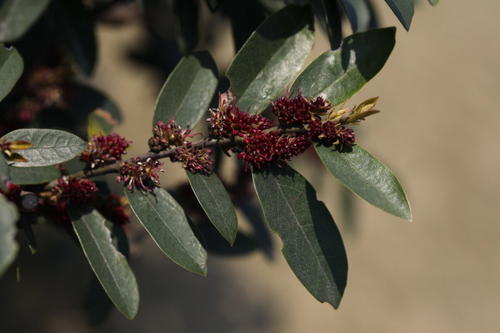Distylium profile
Written by Maggie
Apr 01 2021

Distylium is an evergreen shrub or medium tree in the family Hamamelischaceae. The tender branches are scaly, the old branches are bald and clean, and dark brown after drying. Buds bare without scaly bracts, scaly. Leafy, elliptic or obovate elliptic, produced in Guangdong, Fujian, Taiwan, Zhejiang and other provinces of China, mostly born in the hills 100 ~ 200m above sea level, also have distribution in Japan. Distylium is often cultivated in urban gardens along the Yangtze River basin.
Distylium picture

The morphological characteristics of Distylium
Branch
Distylium is an evergreen shrub or medium tree, scaly young shoots, bald old ones, dark brown when dry; Buds bare are without scaly bracts, scaly.
Leaf
Distylium leaves are leathery, oblong or elliptic, oval 3 ~ 7 cm long, 1.5 3.5 cm wide, apex obtuse or slightly acute, base broadly cuneate, dark green, shiny, following the early scale have scales, later go bald net, lateral veins 5 ~ 6 pairs, above is not obvious, in the following slightly protuberant, net veins on both sides are not obvious, the edge without serrate; Petiole is 5 ~ 10 mm long, slightly scaly. Stipules are fine, caducous.
Flowers
Distylium racemes ca. are 2 cm, racemes glabrous, involucre 2-3, ovate, scaly; Bracts are lanceolate, 3 mm long, flowers male and female in the same inflorescence, female flowers at apex; Calyx tube is short, calyx teeth unequal in size, scaly; Stamens are 5 to 6, filaments ca. 2 mm, anthers 3.5 mm, red; Ovary stellate tomentose, style 6 -- 7 mm long.
Fruit
The capsule of distylium is ovoid, 1 -- 1.3 cm long, apex acute, outside with brown stellate villi, upper halves split, each 2-lobed, without persistent calyx tube, fruit pedicels short, less than 2 mm long. The seed is ovoid, 4 ~ 5 mm long, dark brown, shiny, seed hilum white.
The ecological habits of Distylium
Distylium is found in subtropical evergreen forests. Most of them are born in hilly areas of 100 ~ 300m above sea level. It is also found in Japan. Distylium is often cultivated in urban gardens along the Yangtze River basin.
Distylium is a light-loving, slightly shade tolerant, warm and humid climate, not strong cold tolerance.
Distylium is not strict with soil requirements and can adapt to both acidic and neutral soils, while well-drained, fertile and moist soils are the best. Sprout, hair branch strong, resistant to pruning.
When to grow Distylium
Plant Distylium anytime of the year as long as the ground isn't frozen. When planting in summer be sure to water deeply an additional time per week.
How to grow and care for Distylium
Sunlight
Distylium grows well in full sun or part shade.
Soil
This evergreen shrub is adaptable to different soils, but performs best in a moist, well-draining soil.
Water
After planting, water deeply about 2 times per week. Once established this plant is drought tolerant. Water in periods of drought for best growth and flowering.
Food
Fertilize these plants with a balanced slow release fertilizer in spring.
Pruning
These evergreen shrubs tolerate heavy pruning, but do not need to be pruned. If needed, prune in early spring after flowering has ended.

Distylium propagation
Distylium can be propagated by sowing and cutting.
Seed propagation
Distylium sowing in autumn to harvest the fruit, the sun thresh, after the net seed dry storage, to the next February to March sowing, the germination rate of 70 ~ 80%. Cutting is inserted with hard branch heel shape in spring, also can be inserted with tender branch heel shape in the plum rainy season. Transplants are performed in autumn, or in spring, with soil balls. After planting appropriate sparse branches and leaves, can ensure survival.
Cutting propagation
Distylium can be propagated from cuttings in spring and summer or by sowing in spring. Wait until the seedlings grow to a suitable size for modeling. Also can use growth for years to plant small, vigorous like mosquito mother old pile making bonsai, normally germinate in the spring or the rainy season before transplanting, carried out on the stump before transplanting a rough cut, cut off redundant branches, root system should also be an appropriate clip, cut off a length of the taproot, stay a lateral root and fibrous root, to do a good job of keeping fresh moisturizing after mining, first planted in underground "blank", made of baked clay or survival after such as modeling, and fine in the basin.
Distylium disease control
Distylium generally has few pests and diseases but is vulnerable to scale insects if it is planted in damp, dark and impermeable places.
Distylium varieties
Distylium ‘Vintage Jade’ (PP23, 128, First Editions®) is the smallest variety, with a compact, mounding boom habit. The foliage is a smooth green. The purple plant life are produced alongside the stem for the duration of February and March. 3’ tall x 4’ wide, Zone 7-9
‘Vintage Jade’ is advocated for small basis plantings, borders, walkways, or as a floor cowl on banks
‘Vintage Jade’ planted in a foundation design.
‘Vintage Jade’ planted in a basis design.
Photo courtesy of Dr. Michael Dirr, Watkinsville, GA
Distylium Coppertone™ (‘PIIDIST-III’ PP25 304 , First Editions®) has a mid-sized to rounded increase addiction with coppery pink new foliage that matures to blue-green.
It additionally has small pink flora in February and March.
3-4’ tall and 4-5’ wide, Zones 7-9
Coppertone™ is endorsed for low-growing hedges, basis plantings, and accents
Coppertone ™ has new bronze reddish-purple foliage in the spring.
Coppertone ™ has new bronze reddish-purple foliage in the spring.
Photo courtesy of Bailey Nursery, Newport, MN and Dr. Michael Dirr, Watkinsville, GA
Distylium Blue Cascade® (‘PIIDIST-II’ PP24,409) has a compact, spreading addiction with darkish blue-green foliage that holds its shade yr round. The new foliage is a bronze-reddish red in the spring. It additionally has pink blooms in February and March. 4’ tall x 4’ wide, Zones 7-9
Blue Cascade® is encouraged for low-growing hedges, basis plantings and accents.
This is the mature peak and width of Blue Cascade®.
This is the mature peak and width of Blue Cascade®.
Photo courtesy of Bailey Nursery, Newport, MN and Dr. Michael Dirr, Watkinsville GA.
Distylium Emerald Heights® (‘PIIDIST-I’ PPAF) has darkish inexperienced foliage. It additionally has the identical flowering traits in February and March as the different Distylium hybrids.
6’ tall and 6’ wide, Zones 7-9
Emerald Heights® is encouraged for privateness hedges, borders, and specimens in basis plantings.
Emerald Heights® is an wonderful alternative for Otto Luyken Laurel in the landscape.
Emerald Heights® is an high-quality substitute for Otto Luyken Laurel in the landscape.
Photo courtesy of Dr. Michael Dirr, Watkinsville, GA
Distylium Linebacker™ (‘PIIDIST-IV’ PPAF, First Editions®) is the tallest range of the hybrids with a compact however upright increase habit. The reddish new foliage matures to a darkish green. It will additionally have small crimson plant life in February and March. 8’ to 10’ tall x 6’x 8’ wide, Zones 7-9
Linebacker™ is advocated for hedges, basis plantings, and upright developing accents.
The Distylium region
Distylium is distributed in Fujian, Zhejiang, Taiwan and Hainan Island of Guangdong Province. Distylium is also found in Korea and the Ryukyu of Japan.
Distylium is also found in Anhui, Jiangxi, Guangxi, Sichuan, Guizhou and Yunnan.
Distylium uses
Medical use
Distylium can treat edema, Edema of hands and feet, Rheumatic joint pain; injuries.
Landscaping purposes
Distylium has dense branches and leaves, neat tree shape, dark green leaves, and does not wither in winter. In spring, small red flowers are also beautiful. Besides, it has strong resistance, good dust and sound insulation effect, and is a green and ornamental tree species in urban and industrial and mining areas. Distylium is suitable for roadside, front lawn and under big trees; Clusters and patches also work well as a space divider or as a background for other flowers and trees.
If trimmed into a ball, it is suitable for planting next to the door or as a base planting material.It can also be planted as hedges and shelterbelts.
The environment tree species
Distylium is highly resistant to smoke and a variety of toxic gases and can adapt to the urban environment. Bark contains tannin, can be produced tannin extract; Wood is hard and can be used for furniture, vehicles, etc. Distylium is resistant to sulfur dioxide and chlorine.

Latest Updated
- Benefits of Bugleweed - 7 Science-backed Health Benefits
- Bugleweed Dangers & Side Effects - Is It Poisonous?
- How to Plant Evergreen Trees - What You Should Know
- When to Plant Evergreens - Grow Guide for Evergreen Trees
- 12 Wonderful Evergreen Shrubs for Your Garden
- 12 Popular Evergreen Plants with Pictures for Beginners
- When And How To Prune A Lilac Bush Like a Pro
- How to Grow & Care for Lilac Vine (Hardenbergia Violacea)
- Japanese Lilac Tree (Syringa Reticulata) Care & Propagation Guide
- Shumard Oak Pros and Cons - What to Know
Popular Articles
- Winter maintenance of Antirrhinum Majus
- How to Grow Terminalia Mantaly Tree
- How to Grow and Care for Crossostephium Chinense
- How to grow Antirrhinum Majus in spring
- Peristeria Elata (Dove Orchid) Profile: Info & Care Guide
- Underwatered Snake Plant (Sansevieria Trifasciata) - Signs And How To Fix
- How to Care for Brazilian Jasmine Plant (Mandevilla Sanderi)
- How to Grow & Care for Graptopetalum Purple Delight in Summer
- Rosa Chinensis (China Rose): Plant Growing & Care Tips
- How to Care for Baby Sun Rose (Aptenia Cordifolia)